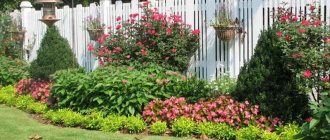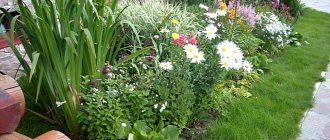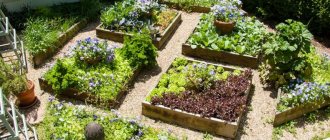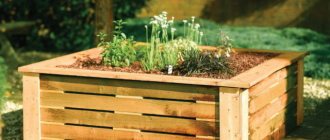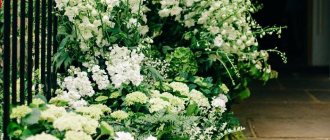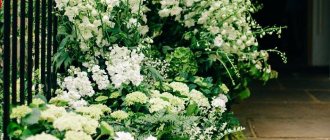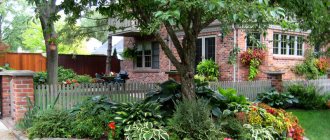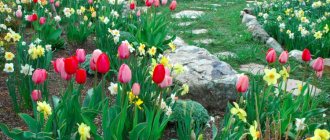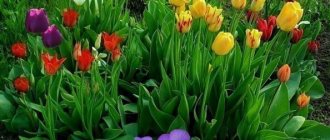The front side of the personal plot is the business card of the owners. Even if there is only a meter of free land between the fence and the road, this usable area can be transformed beyond recognition.
Some summer residents fence their land holdings with a chain-link fence or wooden picket fence, others prefer to hide from prying eyes behind a blank fence made of corrugated sheets or enclose the area with a brick wall.
The type of fence is a matter of taste and financial capabilities of everyone. But in front of any fence there is usually a piece of land left, which you also don’t want to let go. What plants should be planted here to transform the entrance to the site and brighten up the dull appearance of the fence?
Lawn
The easiest way to improve the area on the outside of the fence is to sow it with lawn grass. Such unpretentious vegetation does not require special care and looks neat throughout the season.
Water the grass when it's dry, feed it periodically, and trim it regularly to maintain its decorative appearance.
- 11 tips for lawn owners
These tips will be very useful for summer residents and owners of private houses.
This option is suitable for “lazy” summer residents, as well as those who do not have the opportunity to “swing wild” in their fantasies due to the limited space between the fence and the road - even a narrow strip of lawn will look much more aesthetically pleasing than sloppy weeds.
Decorative fence
The gate should be complemented by a fence designed in the same style. If the fence conflicts with the gate or exterior elements, the impression of the entire entrance area will be spoiled.
- For metal gates, a wrought iron fence with brick or stone supports is suitable.
- For areas where natural materials and colors predominate in the exterior decoration of the house, it is worth choosing laconic wood-look blinds.
Annual flowers
You can plant the area along the fence with annual flowers. With this approach, you will have the opportunity to change the “scenery” every year. For example, in the coming season you can organize a long yellow-orange flowerbed here, and next year “paint” it in red tones.
- 17 annuals with yellow and orange flowers - let the sun into the garden!
Yellow and orange annuals will add light and sunny notes to your flower garden. Be sure to plant them in your garden!
- 15 annuals with red flowers - bright colors in your garden
Do you want to add bright accents to your flower garden? Red annuals will help you do this without any extra work.
When choosing flower crops, take into account the characteristics of each: in what period does it bloom, does it like the sun or is it ready to withstand shade, how resistant to drought is it? If you choose the right company of annuals, you can achieve a continuous riot of colors from spring to late autumn - the neighbors will not remain indifferent.
Give preference to non-capricious plants: marigolds, nemophila, alyssum, cornflowers, gypsophila, clarkia, limnanthes, calendula, eschscholzia, catharanthus, petunia, lobelia, dimorphotheca, cosmos, zinnia, iberis, etc.
Decorative leafy annuals will look great on the outside of the fence: coleus, perilla, irezine, ornamental cabbage, silver cineraria, castor bean, kochia, etc. You can create a spectacular ensemble only from decorative leafy crops or plant them in company with flowering plants.
What to consider when making a plan
The less free time you have to care for your local area, the simpler it should be.
- Assess the location of the palisade relative to the cardinal directions. Select plants based on their light or shade tolerance.
- The plants should be familiar to you, and caring for them should be within your capabilities. Soil composition can also influence the choice.
- When drawing up a plan for each shrub or tree, set the dimensions corresponding to the dimensions of an adult plant. At the initial stage, for example, a thuja can be 20-30 cm in diameter, and when it grows, it can be up to one and a half meters. To avoid having to replant your mature plantings in the future, leave each of them sufficient space to develop.
Perennial flowers
If you don’t want to bother yourself with sowing annuals every spring, opt for perennial flower crops - there are fewer worries with them.
Take a closer look at the bulbous plants that do not need to be dug up annually: tulips of the 13th-15th classes, colchicum, pushkinia, daffodils, galanthus, scylla, crocuses, bulbous irises, chiondoxa, erythronium, white flower, erantis, lilies, muscari, etc.
- Bulbous flowers that do not need to be dug up for the winter
Do you dream of decorating your garden with bulbous plants, but don’t want to bother with digging them up and storing them? Then these thirteen colors will suit you.
Other unpretentious perennials will catch the baton of flowering: astilbe, loosestrife, bergenia, irises, peonies, echinacea, rudbeckia, gaillardia, perennial chrysanthemums and asters, cornflower, lupins, decorative yarrow, pyrethrum, phlox, garden violets, daylilies, etc.
- 15 perennials that bloom all summer
A selection of popular and unusual perennials for the garden!
- Unpretentious express perennials that bloom in the first year
What perennials should you plant in your flowerbed so that they will delight you with their flowering in the near future?
Take ornamental foliage perennials as companions to flower crops: hosta, heuchera, Steller's wormwood, large-leaved brunnera, green grass, sugar lungwort, etc. Ornamental grasses would be an excellent solution: maned barley, blue keleria, miscanthus, bulbous ryegrass, sand elymus, soddy pike and etc.
- My silver garden – 10 plants with silver leaves
Plants with silver-tone leaves will turn your garden into a cover garden.
- Ornamental grasses for the middle zone - these plants will definitely not freeze in winter!
Ornamental grasses can literally transform a garden in a couple of seasons. But not all of them can survive our winters.
Stages of landscaping the area in front of the house
If you have an area in front of you that needs to be improved from scratch, you need to follow certain steps.
Territory marking
What is drawn on the paper plan must be transferred to the area. Mark the corners, future outlines of paths and flower beds.
Arrangement of paths and paths
To create paths, a fairly deep layer of soil is removed and drainage is laid. Then a layer of sand cushion is poured, which must be compacted well. After preparing the base, tiles or natural stone are laid. More information about the structure of the tracks can be found here.
Preparing the soil for planting
After you have marked the boundaries for future plantings, you should remove the top layer of soil - the turf. Dig up the area intended for planting. Add a nutrient substrate to lighten the soil - humus, peat. Lay a border strip around the perimeter. It is installed flush with the ground and allows you to avoid the spread of weeds in the future. If the dug up area borders the lawn, the border tape will make the outline clear.
Purchase of planting material
According to the planting plan, make a list of necessary plants. What matters here is the budget you have. The older the seedlings, the more expensive they will cost. But at the same time, you will have to wait less time for your palisade to achieve its decorative effect. If your budget is limited, you can turn to friends or relatives for cuttings or plots of plants after autumn replanting. You can buy small seedlings, they will be cheaper. But in this case, you will have to wait two or three seasons until they can please you. In the case of slow-growing varieties, it takes much longer.
Planting plants according to the drawn up diagram
Look at the requirements for each crop in advance. Is it necessary to lay drainage, does the soil require acidification or neutralization, what size should the planting holes be. Remember that the list of plants must correspond to the available light. Do not plant light-loving plants on the north side, and shade-loving plants in the sun (south and southeast).
Improvement of the space between plantings
To make it easier to maintain the front garden in the future, lutrasil is placed between the planted plants. It is covered with a layer of mulch on top. Both stone chips and tree bark are used. This will also decorate your local area and make the appearance complete.
When finishing the arrangement, be patient. And in just a couple of seasons you will be able to enjoy the landscaped area in front of the house.
Lianas
If your fence is made of chain-link mesh or other cellular material, climbing plants will be an excellent option for decorating the front side of the area. You can plant a new annual vine every year: morning glory, climbing varieties of nasturtium, sweet peas, fire beans, climbing kobe, dolichos, echinocystis lobes, quamoclitis lobes, winged thunbergia, climbing asarina, etc.
- The best flowering annual vines for the garden (25 photos)
These annual climbing plants are perfect for your garden!
Plant decorative foliage or flower crops at the foot of the vines. An alternative is to sow the remaining strip of land between the “climbing” fence and the road with lawn grass.
A durable fence can be decorated with perennial vines: ivy, tree pliers, virgin grapes, hops, actinidia, Chinese lemongrass, campsis, climbing roses, clematis, wisteria, honeysuckle honeysuckle, fluffy calistegia, petiole hydrangea, etc.
- Perennial vines for sunny and semi-shaded gardens
7 flowering vines for a sunny garden - with tables, photos and descriptions.
To make perennial vines look decorative, you will need not only to water and feed them, but also to trim them regularly - many of them turn into insidious invaders over time.
Front gardens “theirs” and “ours”
Unfortunately, in our country, front gardens in general, much less beautiful, elegantly executed ones, are rare. The reason for this, obviously, is the existing way of life, which involves fencing off from the whole world with high, solid fences. In this case, the very idea of setting up a front garden—a decoration in front of the house, on display for everyone—loses its meaning.
What kind of artistic techniques can you find in the design of small plots of land under the windows or in front of the entrance to a Dutch, German or Belgian house! Flat parterres and compositions using geoplastic techniques are adjacent, miniature slides, retaining walls and borders made of wood or stone rise. Concrete containers, ceramic flowerpots and boxes made from boards and old sleepers are hidden under cascades of hanging annuals.
Numerous options for paving and filling the surface with crushed stone, pebbles or gravel screenings alternate with the greenery of short-cropped tiny lawns. There are large stones: boulders, flat slabs or angular fragments of rock, reminiscent of islands, surrounded by a foamy surf of sedums, chives or thyme.
Many areas are dominated by flower front gardens, which reveal all the benefits of continuous flowering gardens. Often there are so-called staffage elements - objects made of stone, metal or wood: hollowed out flower boxes, birdbaths, antique plows and anchors, as well as original garden furniture made from driftwood or roots. Old stumps and wood cuts are turned into flowerpots or pedestals.
Shrubs
Tall varieties of shrubs will help to decorate a “transparent” fence and brighten up the dull appearance of a continuous fence made of corrugated sheets: barberry, lilac, hawthorn, spirea, mock orange, viburnum, chokeberry, serviceberry, dogwood, hydrangea, dogwood, forsythia, Japanese kerria, bladderwort, etc. From shrubs, you can create a dense hedge or plant several crops sparsely so that you can appreciate the beauty of each.
- 13 ornamental shrubs and trees that bloom in April-May
A selection of charming plants that will decorate your garden in spring.
- 17 spectacular shrubs that will decorate the garden in autumn
A selection of ornamental plants that are attractive both in summer and autumn.
Do not forget to regularly remove root shoots and form a beautiful shape of the crown of the bushes so that they look impressive.
Low-growing shrubs will look advantageous along the fence - you can use them to create an elegant border. Take a closer look at Japanese spirea, birch-leaved meadowsweet, fruticose cinquefoil, dwarf varieties of Thunberg barberry and boxleaf barberry, Dummer cotoneaster, creeping willow, grass erica, dwarf caragana, etc.
- Low-growing ornamental shrubs for rock gardens and small gardens
Look at miniature varieties of decorative deciduous shrubs.
Flowerbeds to decorate the entrance to the site
Beautiful flower beds at the front gate are most often made with your own hands in the form of symmetrical compositions on both sides of the entrance. A continuation of the flower bed are border flower beds along the path that leads to a private house. Before creating flower beds and planting, it is recommended to draw a diagram and select plants.
Here are some interesting options for a simple flower bed near the gate:
Option 1. Symmetrically planted western thujas, surrounded by wild strawberries, spring crocus, subulate phlox and scaly juniper. You can also plant crocuses along the paths as a border flower bed.
Option 2. Virginia juniper is planted as an all-season compositional center of a beautiful flower garden, around it is blue cyanosis, fortune euonymus, and woolly yarrow.
Option 3. Asymmetrical flower garden, on one side a prickly spruce is planted in a flowerbed near the gate, with rhododendron and heather around it. On the other side, European larch is planted on a small hill of the ground, and on the lower tier - ruddy Erica and black dropsy.
Option 4. To design a rustic landscape design, you can use a composition of the following plants: pedunculate oak, small-flowered and mountain pine, fescue, juniper, euonymus, blue molinia.
It is recommended to design the path leading to a private house taking into account the choice of plants for the flower bed, so that a simple, unified composition is maintained. When choosing conifers and low-growing perennials, you can use lavender or other interesting types of low-growing plants as a border flower garden.
The advantage of using conifers as ornamental plants for decorating flower beds is the all-season nature of such flower beds, so they are optimal for creating a rustic landscape with your own hands.
Trees
If space allows, plant trees along the fence in a long row. Give preference to unpretentious deciduous trees that can easily be trimmed and will allow you to give your crown any shape: linden, various types of maples, rowan, elderberry, bird cherry, aspen, loosestrife, etc.
- How to choose the right tree for the garden
Someone thinks that their plot is too small to plant a couple of trees there. It's a delusion! Trees don't take up much space in the yard, especially if you cut off their lower branches.
- 5 trees and shrubs with purple and red foliage - adding accents to the garden
Do you want to add some bright strokes to your garden picture? See what plants will help you do this.
Coniferous crops will add special sophistication to the front side of the plot: yew, thuja, larch, juniper, spruce, pine, etc. For planting, select plants with a compact crown - today there is a wide variety of decorative coniferous species.
- Coniferous trees in the garden - what you need to remember when planting and growing
In order for a coniferous tree to become a real decoration of your garden, it is important not only to purchase a nice tree, but also to find suitable neighbors for it.
- What can be planted next to conifers - examples of successful plant combinations
The fashion for coniferous plants in the garden is gaining momentum. What to combine them with and how to plant them to get not only a beautiful, but also a viable landscape?
Anything is possible if you're careful
No matter how your imagination plays out in arranging the “sub-fence” territory, do not forget about the main thing: if you ennoble it, then this does not make it yours. This land has been and will remain the property of the SNT board - rarely do any summer residents, when constructing a fence, retreat deeper into the site in order to allocate an additional plot for a street front garden.
Therefore, before planting a strip of land along the road with any crops (especially bushes and trees), take the trouble to coordinate your plans with the chairman of your gardening association. He can prohibit “clogging” an already narrow street with plants that will interfere with the passage of fire equipment and pose a threat to power lines with their lush growth.
If today you decide not to bother yourself with such approvals, then tomorrow when you arrive at your dacha you may find all your trees and bushes cut down - board members have the right to do this.
It would be a good idea to discuss your plans with your neighbors. Will two cars be able to pass each other on your street if you plant flower bushes near the fence? Won't your hedge scratch your neighbor's car when he leaves the property? Will your maple and linden trees cast a thick shadow on someone else's fence - perhaps the neighbors want to decorate their chain-link fence with a light-loving vine?
The empty land on the outside of the fence can be transformed by a wide variety of crops - it all depends on your imagination. But if a neighbor drives his Lada through your daisies, there will be no one to file a claim with - you have been beautifying the public area on a good basis.
